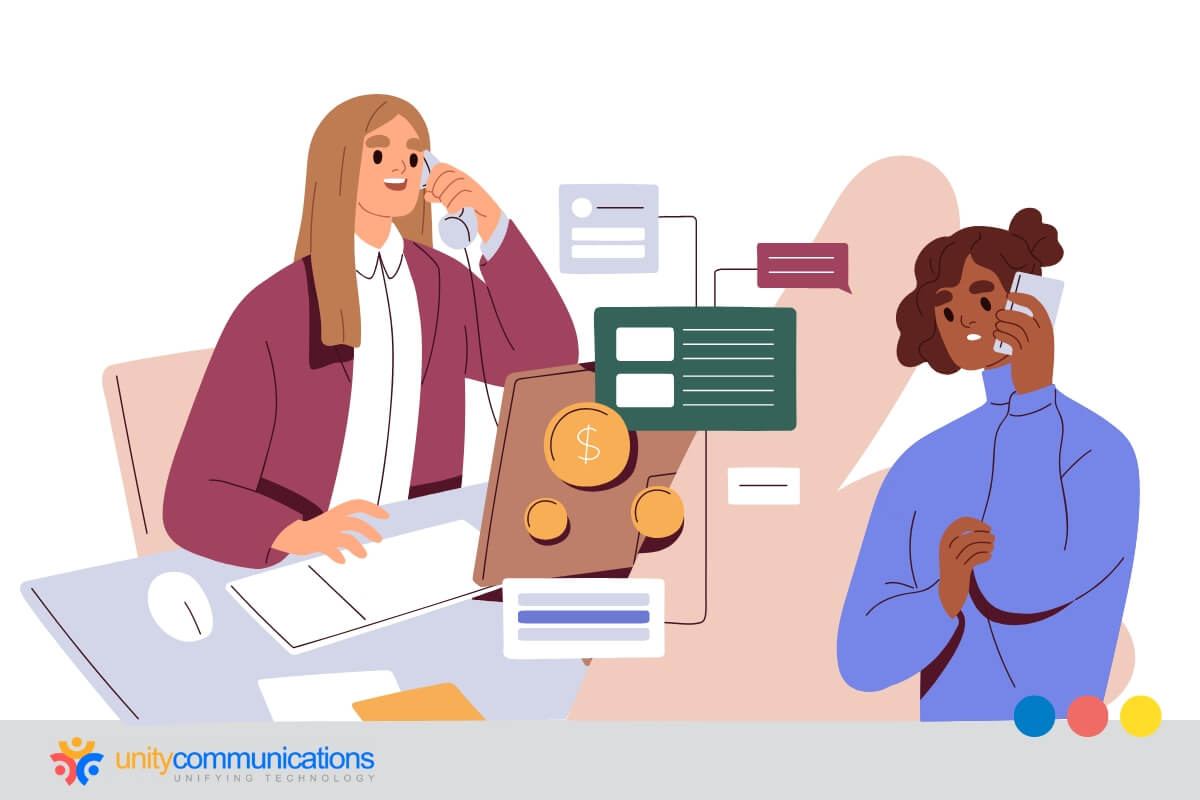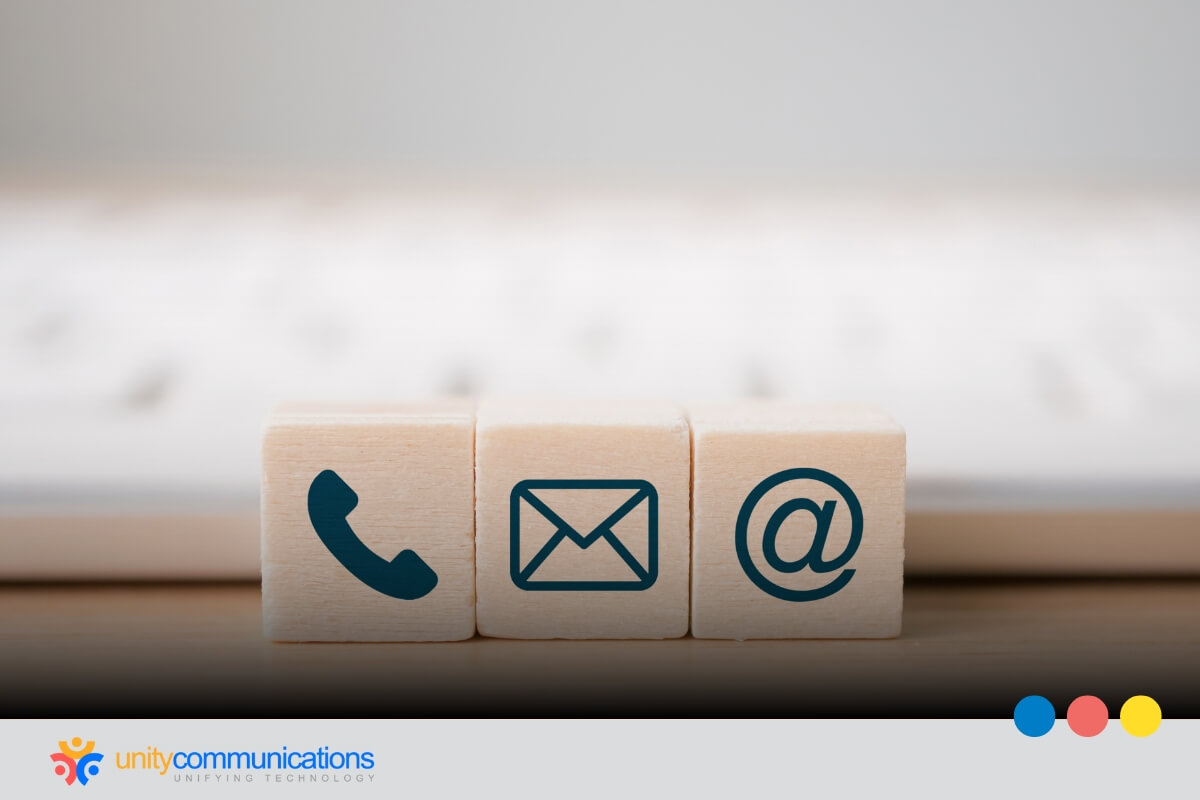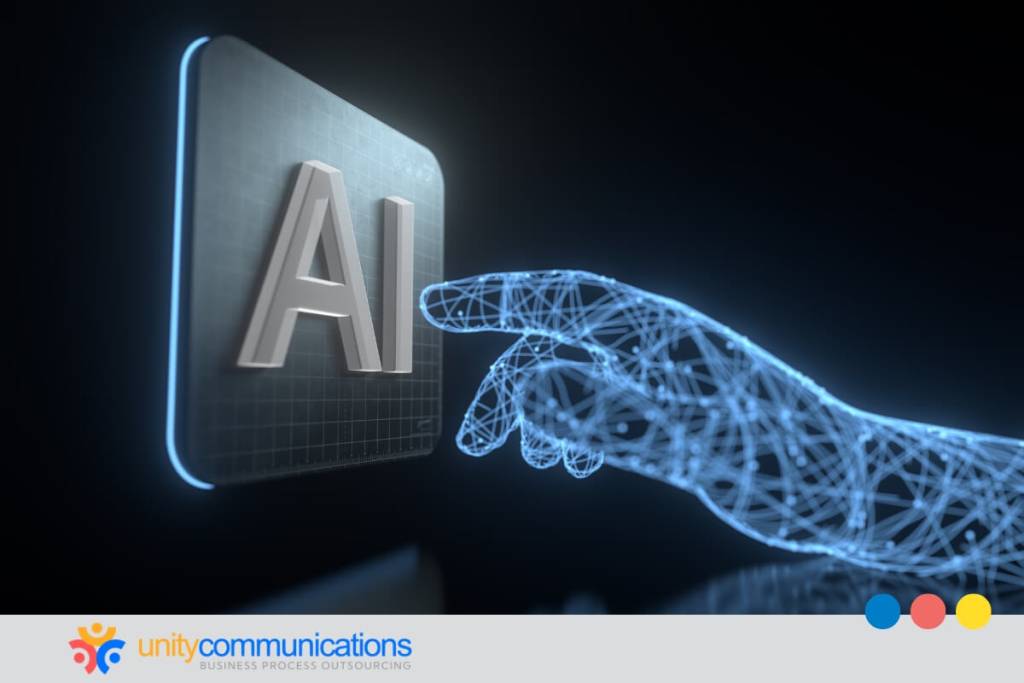Table of Contents
The customer service landscape is experiencing massive changes brought about by shifting consumer behavior and technological developments. Businesses must adapt to remain relevant and stay ahead of the competition.
Companies worldwide can rely on contact and call centers to manage customer complaints and keep them happy.
This article tells you everything a contact center as a service (CCaaS) does. It explores contact and call center functions and key features.
Six Main Contact and Call Center Activities

Contact centers manage several customer service activities. Their responsibilities include answering customer calls, replying to emails about product inquiries, connecting clients to the appropriate department, solving technical problems, and more.
To help you better understand contact center technology, we give you a closer look at the primary duties and responsibilities of contact and call centers.
1. Telephone Service
Contact centers are modern versions of call centers. They manage a large volume of inbound and outbound calls. They aim to meet client expectations with interactive and efficient customer service, technical support, and sales assistance over the phone.
- Inbound calls. These calls are incoming tickets that contact centers receive. Call center agents manage all incoming calls from customers. For instance, a customer has a question about connecting a device bought from your company. The customer service agent receives an incoming call from that customer to get help set up.
- Outbound calls. These calls are outgoing calls that contact center agents make. Such calls might be part of lead generation campaigns, surveys, or a direct sales strategy. For instance, a health insurance company calls potential leads to explain insurance coverage and convert them into clients.
2. Text Messaging
Long wait time, language barriers, transferred calls, etc. are common customer complaints about call-based support. In such cases, text messaging can help improve the experience and keep customers happy.
Text messaging is personal, fast, and safe. Moreover, it boosts agent productivity because they can interact with multiple customers simultaneously.
Contact and call centers use text messaging services to:
- Send proactive updates regarding customer problems
- Rate service quality and ask for feedback
- Conduct consumer surveys
- Start two-way interactions
From phone calls to text messaging services, Omnichannel support allows you to manage inbound and outbound client communication effectively.
3. Chat Service
Instant messaging, or chat service, is a prominent customer service tool. Its intuitiveness and fast response make it a popular choice among consumers.
Chat support also maintains high first contact resolution (FCR), which measures a contact center’s ability to solve issues on the first interaction.
A client can start a non-voice conversation using a specialized chat widget on the brand’s website. The chat window connects the customer to a chatbot or human agent who will resolve the problem.
Contact and call centers offer two types of chat support.
Chatbots
Customer service Chatbots are becoming popular communication tools due to their ease of use and efficiency. Over 62% of customers prefer using chatbots to waiting for human agents to respond.
Contact centers include chatbots that use artificial intelligence (AI) to communicate with customers. The chatbot gathers relevant data about the issue and answers simple questions without human intervention. The chatbot escalates the problem to the appropriate representative if it needs agent assistance.
Contact centers also use chatbot technologies to:
- Identify the urgency and type of problem
- Push tickets on top based on the urgency level
- Identify client needs and provide relevant answers
- Reduce customer churn
- Make agent handover for complicated problems
- Provide instant assistance without making clients wait
- Answer repetitive questions such as order status, delivery time, and return policy
- Provide round-the-clock support
Live Chat
Live chat is a vital technology for contact centers, different from chatbots as it involves direct human interaction. It’s becoming the preferred choice for customer service because it’s more cost-effective than voice support.
A notable aspect of live chat is its impact on wait times. According to the Comm100 2023 report, the average live chat wait time has decreased to 30 seconds, reflecting a 17% reduction from the previous year. This significant decrease demonstrates live chat’s efficiency in:
- Addressing client needs in real-time
- Reducing reliance on interactive voice response (IVR) systems
- Improving first-contact resolution rates
- Substantially lowering customer wait times
Customers who favor self-service find live chat and chatbots particularly effective for resolving common issues.
4. Social Media Service
Social media is a critical channel for customer experience and satisfaction. With the rise in social media usage, consumers increasingly turn to these platforms to find products and services, underscoring the need for prompt customer service responses.
Facebook has 2.93 billion monthly active users, and over 67% of them log in daily, according to Hootsuite’s 2023 Social Media Trends Report. This shows social media’s customer service reach and engagement potential. Instagram statistics are also telling, with 62.3% of users engaging with businesses and 70% open to ads while watching videos.
High engagement rates on these platforms require contact centers to provide quick and effective social media support. Customers now often ask questions via direct messages, brand-tagged posts, or comments. With Facebook and Instagram’s high usage and engagement rates, these channels are essential for quickly resolving customer issues.
Contact centers leverage digital platforms like WhatsApp, Twitter, and Facebook for social media support, focusing on:
- Active monitoring of social media platforms and mentions. Recognizing the impact of public complaints on social media, contact centers actively monitor for mentions and engage with user-generated content related to your brand, ensuring prompt responses.
- Acknowledging issues publicly and resolving them privately. They quickly respond to social media inquiries and often transition the conversation to a private channel for detailed resolution, maintaining customer satisfaction and privacy.
Effective social media support requires skilled agents who understand these platforms’ dynamics and can respond quickly. For businesses lacking in-house expertise, partnering with a reputable business process outsourcing (BPO) company is a strategic approach to ensuring efficient social media customer service.
5. Email Service
Many customers prefer email as a support channel. Email support represents one of the largest opportunities to drive customer satisfaction and loyalty.
Typically, contact centers use email management software to organize a large volume of emails. Such solutions enable customer service agents to manage customer inquiries efficiently. Moreover, email management software has templates that make responding to customers easier, provide standardized support, and improve client satisfaction.
Here are other ways contact centers provide support using email:
- Automate responses. Contact centers preempt customer inquiries using an automated email corresponding to your current procedures. For instance, they email customers with booking confirmation or order shipping. Contact centers proactively tackle customer inquiries by eliminating important but cumbersome tickets from live agents.
- Integrate into an omnichannel experience. Your client’s email address is a piece of important information in their profile with your brand. Whether they initiate the interaction by emailing you directly or using the email function on their account dashboard, a contact center will align the incoming message with their existing data.
- Provide fast, professional, and 24/7 assistance. While customers allow slower responses with email than chat, a quick reply to email inquiries can significantly improve experience and satisfaction. A contact center specializing in email support also delivers round-the-clock assistance for customers abroad.
6. Dispatch Service
Contact and call center dispatching combines a customer’s urgent needs with the right available agent to solve the problem. The call center connects the customer with the best agent to handle the issue. The range of service requests is wide because dispatching is necessary for medical emergencies, urgent repairs, and sales.
Companies program the dispatch service into the script for it to become a part of the call center protocol. They specifically advise the agents on which situations warrant a dispatch and which ones don’t. They also assign a staff member to contact for every issue.
Call centers handle dispatch services by:
- Managing call center software. Dispatchers use call center software to identify whom to contact and for what purpose. The call center is then responsible for configuring and managing the software.
- Monitoring data and schedules. Call centers ensure that each dispatch schedule is up to date and all contact numbers are working. Failure to update data after each change creates room for dispatching errors and delays.
- Programming important data into the system. Programming all information into the call center software automates the dispatching procedure. The result is faster call time, lower bills, and happier staff and customers.
- Establishing a driving question. A driving question is the initial greeting that drives the call and determines the ticket’s urgency. The agent asks what the issue is for an urgent call and connects the caller accordingly. If the issue is not urgent, the caller can request a call back when the service reopens.
- Managing multiple contact numbers. Some companies keep normal and urgent requests separate using two contact numbers. For instance, one number is dedicated to new customers visiting the website for the first time and another to existing clients with urgent requests. Using two numbers streamlines calls and differentiates the type of concern.
How Do Contact and Call Centers Manage a Call?

Contact and call centers employ a standard procedure when answering and handling calls. When there is a customer service call, a call center agent:
- Answers the call as soon as possible
- Actively listens to identify the customer’s needs
- Verifies the caller’s identity by asking security questions
- Uses problem-solving and interpersonal skills to arrive at an effective solution
- Finishes administrative tasks such as recording customer information and details about the inquiry, complaint, and actions taken
- Completes all call reports and notes
- Ensures all information from the interaction is stored and updated in the organization’s CRM
- Makes follow-up calls for complex customer problems
Important Contact and Call Center Features for Better Services
Responsive and efficient customer service helps enhance engagement and meet consumer expectations. So contact and call centers must focus on features that streamline and optimize customer support. Some of the features include:
- Scripts. These allow representatives to provide the caller with effective support by personalizing each message. Scripts also help maintain a specific brand image in your support service.
- Call conferencing. Contact centers use sophisticated tools that allow callers to create a conference call.
- Call recording. Recording outbound and inbound calls enable contact centers to track agent performance and customer satisfaction. It also gives a reference for solving any complaints or disputes in the future.
- Contact database. Contact and call centers collect interaction history and customer data in one area using CRM software, making it easier for agents to get the right context for conversations.
- Real-time reports. Real-time reports use advanced analytics to gain insight into customer experience and agent productivity across multiple platforms.
The modular structure of contact and call centers also allows managers to improve team operational efficiency and prevent staff burnout. All these features enable contact centers to offer high-quality support and a positive experience.
Key Contact and Call Center Technologies

Contact centers use advanced customer service software to ensure a positive experience and maximize satisfaction.
Let’s explore the popular software contact and call centers use.
- Email response management system. This system collates and analyzes customer inquiries sent via email and routes them to the right agent.
- Knowledge management system. This software is a centralized system that stores all customer information. A knowledge management system lets you search for relevant data and minimize agent training time.
- Workforce management system. This tool helps managers schedule agents and solves staffing issues. Managers can also use this system to track agent productivity and performance.
- Interactive voice response (IVR) system. IVR, otherwise known as a phone tree, enables callers to use voice prompts or the keypad to determine and connect themselves to the appropriate agent for problem resolution.
- Automatic call distributor system. This system enables you to manage incoming calls depending on specific instructions. It analyzes the purpose of the call and distributes it to agents based on the type of support needed, agent availability, etc.
The Bottomline
Contact and call center services play a crucial role in your business. Nowadays, companies that offer the best customer service earn maximum loyalty and higher engagement. Delivering the right support and using the right technology in your contact center is crucial for your business’s growth.
With modern contact centers, businesses across all sizes can scale easily and incorporate omnichannel support as they grow and their requirements change.




